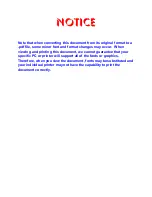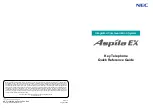
10
Range
Your new phone is designed to achieve the maximum possible
range by transmitting and receiving according to the highest
specifications set forth by the FCC. We have rated this phone to
operate at a maximum distance with the qualification that the
range depends upon the environment in which the telephone is
used. Many factors limit range, and it would be impossible to
include all the variables in our rating. The Maximum Range
rating of this phone is meant to be used as a means of
comparison against other range claims.
Telephone Line Problems
The FCC has granted the telephone company the right to
disconnect service in the event that your phone causes problems on
the telephone line. Also, the telephone company may make
changes in facilities and services which may affect the operation of
your unit. However, your telephone company must give adequate
notice in writing prior to such actions to allow you time for making
necessary arrangements to continue uninterrupted service.
If you are having trouble with your telephone service, you must
first disconnect your phone to determine if it is the cause of your
problem. If you determine that it is the cause, you must leave it
disconnected until the trouble has been corrected.
Radio Interference
Radio interference may occasionally cause buzzing and humming in
your cordless handset, or clicking noises in the base. This
interference is caused by external sources such as TV, refrigerator,
vacuum cleaner, fluorescent lighting, or electrical storm. Your unit is
NOT DEFECTIVE. If these noises continue and are too distracting,
please check around your home to see what appliances may be
causing the problem. In addition, we recommend that the base not
be plugged into a circuit that also powers a major appliance
because of the potential for interference. Be certain that the antenna
on the unit is fully extended when needed. In the unlikely event that
you consistently hear other voices or distracting transmissions on
your phone, you may be receiving radio signals from another
cordless telephone or other source of interference. If you cannot
eliminate this type of interference, you need to change to a different
channel. Finally, it should be noted that some cordless telephones
operate at frequencies that may cause interference to nearby TVs
and VCRs. To minimize or prevent such interference, the base of
the cordless telephone should not be placed near or on top of a TV
or VCR. If interference is experienced, moving the cordless
telephone farther away from the TV or VCR will often reduce or
eliminate the interference.
More Than One Cordless Telephone
If you want to use more than one cordless telephone in your home,
they must operate on different channels. Press the channel key to
select a channel that provides the clearest communication.
Cordless Telephone Privacy
Cordless telephones are radio devices. Communications
between the handset and base of your cordless telephone are
accomplished by means of radio waves which are broadcast
over the open airways. Because of the inherent physical
properties of radio waves, your communications can be received
by radio receiving devices other than your own cordless
telephone unit. Consequently, any communications using your
cordless telephone may not be private.
Installation Considerations
Selecting a Location
Before choosing a location for your new phone, there are some
important guidelines you should consider:
• The location should be close to both a phone jack and
continuous power outlet. (A continuous power outlet is an AC
outlet which does not have a switch to interrupt its power.)
• Keep the base and handset away from sources of electrical
noise such as motors or fluorescent lighting.
• The base can be placed on a desk or tabletop or mounted on
a standard telephone wall plate.
• You should charge your new phone for 15-20 hours before
completing the installation or using the handset.
Telephone Line Outlets
There are two types of phone outlets:
Modular Jack
Most phone equipment available now uses modular jacks.
Phone cords are fitted with a molded plastic connector which
plugs into this type of jack. If you do not have modular phone
jacks, contact your local telephone company for information
about their installation.
Hardwired Jack
Some equipment is wired directly to a phone jack, and these
types of installations require a modular jack converter. This type
of installation is not difficult; however, you should contact your
Uniden telephone dealer or a telephone supply store for advice
about the proper adapter or converter for your particular
situation.
Connecting the Telephone Cords
Consider these safety guidelines before connecting the
telephone cords:
Caution!
• Never install telephone wiring during a lightning storm.
• Never touch uninsulated telephone wires or terminals unless
the telephone line has been disconnected.
• Use caution when installing or modifying telephone lines.
Applying Power to the Base
This phone requires an AC outlet, without a switch to interrupt
power, and the included AC adapter. To relieve strain on the DC
plug when the phone is placed on a desk or table, wrap the
power cord around the strain relief notch on the back of the
base.
NOTE:
Place the power cord so that it does not create a trip
hazard, or where it could become chafed and create a
fire or other electrical hazards.
I.C. Notice
TERMINAL EQUIPMENT
Notice:This equipment meets the applicable Industry
Canada Terminal Equipment Technical Specifications.
This is confirmed by the registration number. The
abbreviation, IC, before the registration number signifies that
registration was performed based on a Declaration of
Conformity indicating that Industry Canada technical
specifications were met. It does not imply that Industry
Canada approved the equipment.
Notice:The Ringer Equivalence Number (REN) for this
terminal equipment is marked on the equipment itself. The
REN assigned to each terminal equipment provides an
indication of the maximum number of terminals allowed to
be connected to a telephone interface. The termination on
an interface may consist of any combination of devices
subject only to the requirement that the sum of the Ringer
Equivalence Numbers of all the devices does not exceed
five.
RADIO EQUIPMENT
The term "IC:" before the radio certification number only
signifies that Industry Canada technical specifications were
met.
Operation is subject to the following two conditions: (1) this
device may not cause interference, and (2) this device must
accept any interference, including interference that may
cause undesired operation of the device. "Privacy of
communications may not be ensured when using this
telephone".
up050.fm Page 10 Tuesday, October 5, 2004 4:12 PM
Содержание EXP 4241 Series
Страница 1: ...EXP 4241 Series OWNER S MANUAL ...






























